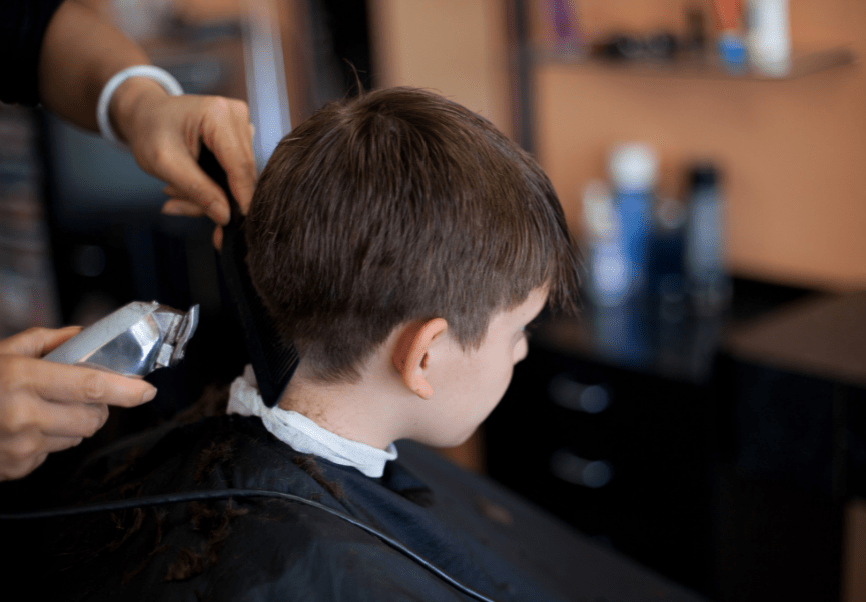Buckley, J., Luiselli, J. K., Harper, J. M. & Shlesinger, A. (2020). Teaching students with autism spectrum disorder to tolerate haircutting. Journal of Applied Behavior Analysis, 53(4) 2081-2089. https://doi.org/10.1002/jaba.713
Reviewed by: Roxanne Gayle, PhD, BCBA-D and Mary Jane Weiss, PhD, BCBA-D, Endicott College
Why research this topic?
 Children with autism often have difficulty completing health care routines such as doctor, dental, and hair appointments. They may engage in behaviors such as noncompliance, aggression, and self-injurious behavior, resulting in safety concerns for both the child and the care provider. Families are often unable to manage behaviors in the community settings, and often avoid such appointments altogether. In order to provide care for these individuals, health care providers may use sedation or restraints, which are invasive approaches to treatment. At times, the procedure known as ‘escape extinction’ is used, requiring the individual to tolerate the experience, regardless of how upset they become. It is important to find less invasive and more compassionate approaches to increase tolerance with health care procedures by children with autism.
Children with autism often have difficulty completing health care routines such as doctor, dental, and hair appointments. They may engage in behaviors such as noncompliance, aggression, and self-injurious behavior, resulting in safety concerns for both the child and the care provider. Families are often unable to manage behaviors in the community settings, and often avoid such appointments altogether. In order to provide care for these individuals, health care providers may use sedation or restraints, which are invasive approaches to treatment. At times, the procedure known as ‘escape extinction’ is used, requiring the individual to tolerate the experience, regardless of how upset they become. It is important to find less invasive and more compassionate approaches to increase tolerance with health care procedures by children with autism.
What did the researchers do?
This study focused on desensitizing the individuals with autism to the clippers used to cut hair. The researcher gradually presented the clippers to the two participants with autism who lived in a group home setting, proceeding very slowly and systematically to ensure adjustment to and comfort with the procedure. The gradual changes in tolerance included adjusting to proximity of the clippers and longer amounts of time the clippers were placed against the scalp before an edible was provided. Pauses were provided throughout the procedure, based on the current amount of time the participant would tolerate the clippers on the scalp. For example, if the participant only tolerated 60 seconds of the clippers on the scalp, they were required to tolerate the 60 seconds, and then an edible was provided with a 30 second pause before the clippers were placed on the scalp again. This allowed for maximal individualization of the approach, and was designed to help the individual adapt calmly to the process.
What did the researchers find?
Both participants in the study were able to complete an entire haircut by the end of the study, following approximately 200 sessions each, and spanning many months.
What are the strengths and limitations of the study?

The study provided further support for the use of graduated exposure as a way to increase tolerance with hair cut appointments, without the use of escape extinction (i.e, simply working through tantrums or noncompliance, while maintaining the demand to tolerate the haircut). This study provides a systematic, positive approach to building tolerance for getting a haircut. A limitation is that the participants’ tolerance of haircuts was not assessed in the natural setting (barber shop or hair salon), which would be an important extension. Ultimately, the goal is to tolerate a haircut at the salon or barber shop.
What do the results mean?
The results of this study indicate that a graduated exposure to tools used within a haircut procedure may lead to successful completion of haircut appointments. The procedure is lengthy in duration, as it took several months to complete; however, it is useful for practitioners to implement. It is important to identify methods to increase tolerance of haircutting as it may reduce stress for individuals with ASD, as well as for their families and care providers. Families may feel relieved that haircuts can be scheduled as needed without difficulty, especially for important events. Providers may feel relieved that they can accommodate these clients without incidents, and may be pleased to be a more inclusive business.
Citation for this article:
Gayle, R., & Weiss, M. J. (2021). Research synopsis: Teaching students with autism spectrum disorder to tolerate haircutting. Science in Autism Treatment, 18(7).
Related ASAT Articles:
- Clinical Corner: Cooperating with dental exams
- Clinical Corner: Learning to manage feminine hygiene needs
- Clinical Corner: How can I teach my son to cooperate with wearing a face mask?
- Clinical Corner: First responders- education in autism
- Diagnosis: Autism – A Family’s Journey to Obtain Effective Treatment
- Book Review: Healthcare for children on the autism spectrum: Medical, nutritional, and behavioral issues

